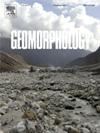Geochemistry and geochronology of modern river sediments from the Heihe River on the northeastern Tibetan Plateau: Implications for weathering and sediment source-to-sink processes
IF 3.1
2区 地球科学
Q2 GEOGRAPHY, PHYSICAL
引用次数: 0
Abstract
Deciphering the sediment source-to-sink processes in modern and dynamic fluvial systems serves as a key to understanding earth surface processes; however, the sedimentary signal preservation and propagation within sediment routing systems are complicated and heterogeneous. We conducted systematic geochemical and Sr![]() Nd isotopic analysis and zircon U
Nd isotopic analysis and zircon U![]() Pb geochronology on fluvial sediments as well as Cretaceous sandstone from the Heihe River drainage basin, located in the northeastern Tibetan Plateau. Fluctuations in geochemistry (i.e., alkali and alkaline-earth metals) close to the average unweathered bedrocks suggest that the silt-sized sediments in the drainage basin form during the early stage of chemical weathering of source rocks. The U
Pb geochronology on fluvial sediments as well as Cretaceous sandstone from the Heihe River drainage basin, located in the northeastern Tibetan Plateau. Fluctuations in geochemistry (i.e., alkali and alkaline-earth metals) close to the average unweathered bedrocks suggest that the silt-sized sediments in the drainage basin form during the early stage of chemical weathering of source rocks. The U![]() Pb ages of detrital zircons from sand-sized sediments show two significant shifts in the upper and middle reaches, i.e., the disappearance of the Tonian-Stenian age group and the dramatic increase of the Cisuralian components in mainstream sediments. Our integrated assessment of source-rock lithology, sedimentary processes, and geomorphological and climatic conditions of the drainage basin led to two important insights: (1) In arid and semiarid environments like Heihe River, chemical weathering in the drainage basin is primarily controlled by geomorphologic and climatic factors; and (2) tributary dilution and en-route storage during the sediment routing systems are key factors responsible for changes in zircon age signatures. The confluence of representative tributaries and geomorphological and climatic transformations significantly influence sediment weathering and transport processes.
Pb ages of detrital zircons from sand-sized sediments show two significant shifts in the upper and middle reaches, i.e., the disappearance of the Tonian-Stenian age group and the dramatic increase of the Cisuralian components in mainstream sediments. Our integrated assessment of source-rock lithology, sedimentary processes, and geomorphological and climatic conditions of the drainage basin led to two important insights: (1) In arid and semiarid environments like Heihe River, chemical weathering in the drainage basin is primarily controlled by geomorphologic and climatic factors; and (2) tributary dilution and en-route storage during the sediment routing systems are key factors responsible for changes in zircon age signatures. The confluence of representative tributaries and geomorphological and climatic transformations significantly influence sediment weathering and transport processes.
求助全文
约1分钟内获得全文
求助全文
来源期刊

Geomorphology
地学-地球科学综合
CiteScore
8.00
自引率
10.30%
发文量
309
审稿时长
3.4 months
期刊介绍:
Our journal''s scope includes geomorphic themes of: tectonics and regional structure; glacial processes and landforms; fluvial sequences, Quaternary environmental change and dating; fluvial processes and landforms; mass movement, slopes and periglacial processes; hillslopes and soil erosion; weathering, karst and soils; aeolian processes and landforms, coastal dunes and arid environments; coastal and marine processes, estuaries and lakes; modelling, theoretical and quantitative geomorphology; DEM, GIS and remote sensing methods and applications; hazards, applied and planetary geomorphology; and volcanics.
 求助内容:
求助内容: 应助结果提醒方式:
应助结果提醒方式:


